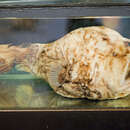en
names in breadcrumbs


View data on Catalog of Fishe here.
Within the size range of 111–274 mm, no distinct changes evident in relative lengths of illicium and escal appendages or in diameter of escal bulb with increasing size of specimens (the low value for length of the distal escal appendage of ISH 18/55a, obtained from the stomach of a sperm whale, may be due to shrinkage, and the short posterior escal appendage of MCZ 29854 appears to have been broken). Each primary branch of distal escal appendage with a simple or bifurcated tip and a pair of short side branches; anterior escal appendage simple in most specimens, bifurcated distally in ISH 18/55b and an additional short appendage above and/or below anterior escal appendage present in LACM 43760-1, ISH 18/55b, and MCZ 29854; posterior escal appendage simple in most specimens, bifurcated distally in ISH 18/55a; distal-most pair of illicial appendages bifurcate; illicial appendages and anterior and posterior escal appendages black, with bright silvery tips in fresh and recently preserved specimens; body and fin rays uniformly black or dark brown; papillae of snout and chin low and darkly pigmented; illicial stem, esca, and escal appendages densely covered with small dermal spinules; 4 or 5 large skin spines on each pectoral peduncle, 40–75 spines on each side of body (in specimens 111–274 mm); dorsal-fin rays 5; anal-fin rays 4; pectoral-fin rays 15–18. The three tentatively identified specimens (32–40 mm) are juveniles, that differ from the larger specimens described above in having much shorter relative lengths of the escal appendages, including a distal escal appendage of 1.0–1.6% SL, less distinct snout and chin papillae, and fewer teeth and dermal spines.
Adult females (111–380 mm) of Himantolophus sagamius differ from those of all other species of the Himantolophus groenlandicus-group in having the following combination of character states: length of anterior escal appendage 11–38% SL; distal escal appendage 6.2–11% (3.1%?) SL; distal lobes of esca blunt; posterior escal appendage 12–41% SL, simple or with bifid tip; 2–4 pairs of posterolateral appendages situated on and below base of escal bulb, length of distal and longest pair 30–45% SL.
Himantolophus sagamius has been recorded from off Japan and along the west coast of the Americas from off northern California to Ecuador and Chile. Two of the three tentatively identified specimens were caught at nearly the same position in the Halmahera Sea; the third specimen is from off Hawaii.
Females of the H. groenlandicus-group differ from those of other species of the genus in having the following combination of character states: The light-guiding distal escal appendage is divided at the base, its total length 0.4–2% SL, shorter than the diameter of the escal bulb in specimens less than 110 mm, 1–11% SL in larger specimens. Each primary branch of the distal escal appendage has a simple or bifurcated tip and 0–2 tiny papilliform side branches. The base of the distal appendage is surrounded by four escal lobes of about equal size. An anterior escal appendage is present in most species (but rudimentary or absent in H. paucifilosus), its length 1.5–42% SL. The posterior escal appendage is longer (about 1.5–34% SL) than the distal escal appendage; its proximal part is undivided, with a simple bifurcated tip, or it is trifurcated (but never bifurcated) at its base (in some specimens it is represented by a transverse series of 2–3 separate, simple filaments). Two to 23 posterolateral appendages are present on and below the base of the escal bulb, the distal-most pair measuring 5.9–49% SL, longer than the posterior escal appendage, and emerging just below the base of the bulb. Small dermal spinules are present on the stem of the illicium, the escal bulb, and the escal appendages of specimens greater than 33 mm. The dermal papillae of the snout and chin are low and rather indistinct. The skin is devoid of “white patches.” The caudal-fin rays are white or only faintly pigmented, with dark tips in specimens less than 70–100 mm, but covered with dark pigment in larger specimens.
Pietsch TW. 2009. Oceanic Anglerfishes: Extraordinary Diversity in the Deep Sea. Berkley: University of California Press. 638 p.
Metamorphosed females known to 380 mm SL.
Sagami Sea, about 35°N, 139°E.
Holotype of Corynolophus sagamius: originally SCMT 8201 (lost or mislaid at ZUMT), 200 mm SL.
The Pacific footballfish (Himantolophus sagamius) is a species found in the Pacific. It has a wide range, extending from the coasts of Honshu (Gulf of Sagami) and Hokkaido islands through the Kuril-Kamchatka trough, in the northwest Pacific, to the eastern Pacific from California to Peru.[1] The footballfish is a species of anglerfish, and is known to live in waters as deep as 3,000 feet (900 m) or 500 fathoms.[2]
The Pacific footballfish (Himantolophus sagamius) is a species found in the Pacific. It has a wide range, extending from the coasts of Honshu (Gulf of Sagami) and Hokkaido islands through the Kuril-Kamchatka trough, in the northwest Pacific, to the eastern Pacific from California to Peru. The footballfish is a species of anglerfish, and is known to live in waters as deep as 3,000 feet (900 m) or 500 fathoms.